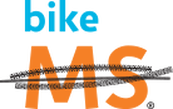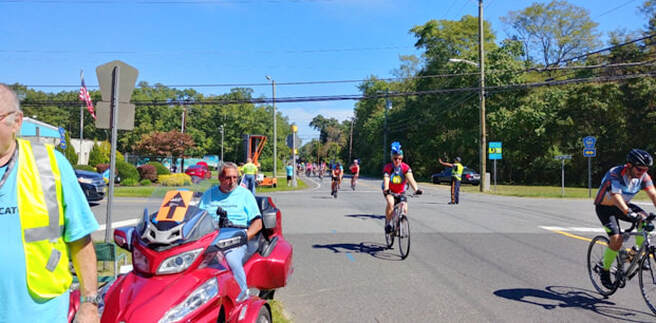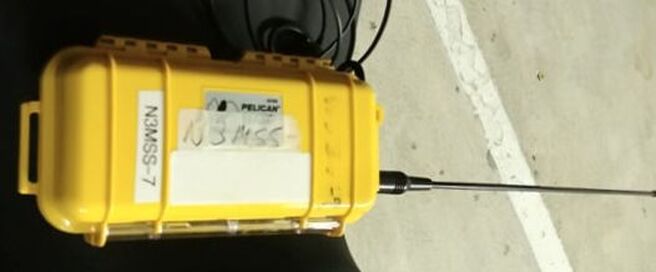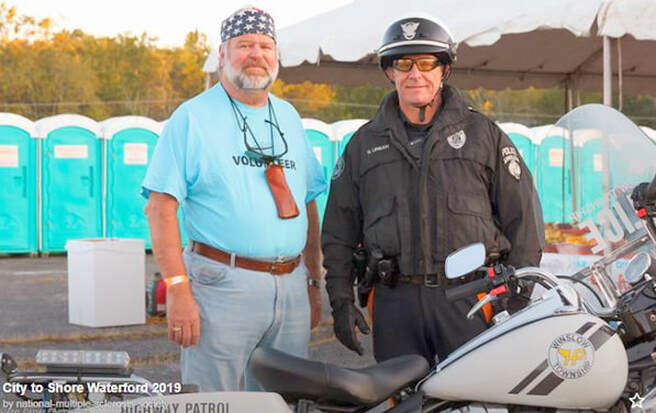Greater Delaware Valley Area Bike MS/Walk MS Events
www.nationalmssociety.org/Chapters/PAE/Fundraising-Events
|
Bike MS: City to Shore 2024 Communication
Specialist Volunteer Registration Form
Contact Information : 609-795-0909;
N3MSSEVCOMM <at> gmail <dot> com
N3MSSEVCOMM <at> gmail <dot> com
Bike MS: Bike To The Bay (Delaware) 2024
October 5, 2024
Sunday, July 14, 2024 - Bike MS : City To Shore Ride 2024 Update
Greetings To All “Bike MS – CITY TO SHORE” Volunteer Prospects
The 2024 event recruitment now begins.
Those of you who volunteered last year remember some very hard times, but one of the main reasons for this late recruitment, is that hopefully we have hammered out most of those problems. As it stands, information will be quicker and smoother this year, and should be a lot earlier.
Hopefully you received our email a couple of weeks ago announcing some of the changes. We hope that this will not hinder our efforts in supporting this event and cause.
The event this year is on the 28th and 29th of September, 2024. In an effort to streamline things and hopefully make it a better experience for everyone, we are asking all volunteers to use the On-Line sign up form which is accessible at : https://forms.gle/LTvdHTUrGgTMZLJH8
All special requests will be addressed if sign ups are in by August 30, 2024.
While we will certainly take all volunteers coming in after that, special requests will be on a case by case basis. Please know that in no way do we want to discourage ANYONE from volunteering, but using this date will make for a much better ease of operations.
Please do not hesitate to contact us at any time with questions, we will answer all questions as promptly as we can, but it may not be immediate.
We would like to thank everyone for your HELP, CONTINUED SUPPORT, AND YOUR CONSIDERATIONS.
We look forward to working WITH everyone again this year.
With Much Appreciation
73
EvComm ([email protected])
Msg. Phone : (609.795.0909)
Monday, June 10, 2024 - Bike MS : City To Shore Ride 2024 Update
Greetings Everyone :
First I want to say THANK YOU to everyone that volunteered in any and all ways last year.
We have not been in touch due to a new philosophy by the Society for all events. Our operations will remain basically the same, but some of the planning and event construction has some changes. Our new sign up form is still under construction, but it should go out next weekend. We do request that everyone use the on-line sign up to make things more uniform.
The biggest change that we have this year is with our housing. Here is the blurb directly from Lauren Trager, Director of Event Production :
“As part of our ongoing evaluation of all National MS Society event expenses, we are updating our strategies to be more in line with the current fiscal environment. For that reason, BikeMS City to Shore has reduced its overall hotel needs. If you live within a 60-minute drive of your event/route area, you will not receive a hotel room. For 60+ or longer distances, it will be evaluated on a case-by-case basis”
I truly hope that this does not cause a mass exodus of our tried and true, and all new volunteers. If you have questions and/or concerns, please do not hesitate to contact me, and I will try my very best to give you a complete and comprehensive answer.
If you are participating in Field Day in a few weeks, I wish you great luck, and hope you have a great time. Hopefully I will see some of you out there.
Thanks Much,
Joe D (KC2SFB)
With Much Appreciation
73
EvComm
Msg. Phone: (609.795.0909)
Greetings Everyone :
First I want to say THANK YOU to everyone that volunteered in any and all ways last year.
We have not been in touch due to a new philosophy by the Society for all events. Our operations will remain basically the same, but some of the planning and event construction has some changes. Our new sign up form is still under construction, but it should go out next weekend. We do request that everyone use the on-line sign up to make things more uniform.
The biggest change that we have this year is with our housing. Here is the blurb directly from Lauren Trager, Director of Event Production :
“As part of our ongoing evaluation of all National MS Society event expenses, we are updating our strategies to be more in line with the current fiscal environment. For that reason, BikeMS City to Shore has reduced its overall hotel needs. If you live within a 60-minute drive of your event/route area, you will not receive a hotel room. For 60+ or longer distances, it will be evaluated on a case-by-case basis”
I truly hope that this does not cause a mass exodus of our tried and true, and all new volunteers. If you have questions and/or concerns, please do not hesitate to contact me, and I will try my very best to give you a complete and comprehensive answer.
If you are participating in Field Day in a few weeks, I wish you great luck, and hope you have a great time. Hopefully I will see some of you out there.
Thanks Much,
Joe D (KC2SFB)
With Much Appreciation
73
EvComm
Msg. Phone: (609.795.0909)
2021 Bike MS Event
By Chris Prioli, AD2CS
The 2021 running of the annual Bike MS City-to-Shore bicycle run took place on September 25th and 26th, with plenty of support by ham radio operators along the way. The Saturday event kicked off in the dark from the PATCO Woodcrest Station parking lot in Cherry Hill, and wound up at the Music Pier in Ocean City, with the opposite route being run on Sunday. The Saturday route included an optional spur route that brought the normal seventy-five mile route up to an even hundred miles, a course run only by the strongest cyclers. Similarly, the ridership on Sunday was a fraction of Saturday’s complement, though a couple hundred riders made the trip on Sunday.
Amateur radio played an important role in the smooth running of the event, with radio-linked communicators staged at various checkpoints along the cyclists’ route. The communicators were tasked with reporting the passing of key event personnel and vehicles, as long as promoting the safety and welfare of the riders by warning them of traffic and/or roadway hazards. The communicators were also tasked with obtaining help via radio for any cyclist who needed medical treatment, repairs, or a lift to the nearest rest or hydration station.
Our Club was well-represented, with the following individuals serving as checkpoint communicators:
- Jim AC2BY
- Bill NJ2S
- Chris AD2CS
- Karl W2KBF
- Harry K2ATX
- Harry W3DNQ
- Sheldon K2MEN
- Greg W5DO
- Darrin KD2ALQ
- Jerry WW2WTF
- Bruce KD2LBU
In addition to the checkpoint communicators, hams staffed other fixed sites such as the start and finish lines and the lunch and rest areas. Also, there was a roving group of hams on motorcycles who patrolled the route watching out for cyclists in trouble between the checkpoints. Among this group was our own Herb KT2Y. Herb was instrumental in getting out the volunteers from among our membership. Information regarding the call signs of non-checkpoint hams was requested from the Event Communications folks, but there has been nothing heard in reply as of this writing.
This event is a great example of amateur radio giving back to our communities and local and national charities. Our folks performed a series of valuable and necessary services, without which the safety and even the very success of the event would have been doubtful. Thank you to all who participated.
Motorcycle…Ham!
By Herb Dyer, KT2Y
Bike MS : City To Shore Ride 2019
By Herb Dyer, KT2Y
Bike MS : City To Shore Ride 2019
|
As a motorcycle rider, have you ever watched the Tour de France bicycle race and seen the motorcycle support bikes and wonder what it would be like to ride along with the peloton? For many motorcyclists this resides only in our imagination. But for one weekend a year in South Jersey, a motorcyclist has the opportunity to experience bicycle support first hand. I had the opportunity to ride a motorcycle 2 days in support of the Multiple Sclerosis Society's “Bike MS: City to Shore Ride 2019” event. The MS 150 is one of the society’s largest fundraising events, with hundreds of participating bicyclists. A 2-day bike race/tour from Cherry Hill NJ to Ocean City NJ. The first day ride route is from Cherry Hill to Ocean City. For the hardcore cyclists that have the energy for the 2nd day, the ride course reverses from OC back to Cherry Hill for 75 miles on Sunday. There are 100-mile, 75-mile, and 45-mile routes combined on the course and cyclists can choose the route that suits their cycling ability. Cyclists get sponsorship from friends, relatives, employers, and others to raise money to help |
those afflicted with Multiple Sclerosis. Along with traffic control from local police units in many towns along the route, hundreds of volunteers donate their time and resources for what could be compared to a military grade logistical and communications operation that spans across the state of NJ.
On the route there are SAG vans (Support And Gear vans for bike repairs and stranded rider pickup), mobile repair shops operated by private bike shops (Support your local bike shop!) and emergency medical services (EMT’s). All these use radio communications on multiple 2-meter frequencies managed by a central command center (net control) located in Ocean City NJ. The US Army would be proud of this communications operation. Ham radio repeater owners/operators donate their repeaters for this weekend and create a linked frequency network that has hundreds of square miles of 2-meter coverage. It’s a herculean feat of radio engineering done by expert Ham volunteers. The BEARS system, K2DX, W2FLY, and K3BR are some of the repeaters pressed into duty. There is also an APRS (Automatic Packet Reporting System) team led by Jim AJ3DI & company that provide APRS beacons for the support vehicles that need them.
In addition to the repeater networks, the Amateur Radio community along with the motorcycling community combine forces along the route to ensure rider safety. Amateur radio operators occupy selected checkpoints (called Checkpoint Communicators) and motorcycle Road Marshalls patrol assigned sections of the route (equipped with cell phones to call for rider support). There are many miles of the course that have large gaps in coverage so in recent years a new support division was created combining both Ham radio and motorcycles. Motorcycle Hams! With a Ham License and the proper radio equipment installed, MC-Hams ride the entire course and fill in the gaps that lack the coverage of Checkpoint Communicators and Road Marshalls. MC-Ham motorcycles are equipped with APRS beacons for tracking on the aprs.fi website by the central command center. Much as the event is a challenge for a beginner bicyclist, Road Marshall and MC-Ham roles are not for the beginner motorcyclist. It requires a highly experienced motorcyclist to support and ride alongside cyclists that are taxing their abilities to the fullest. Due to the constant stream of visual and audio inputs motorcycle riding skills must be instinctual.
As a first time MC-Ham I joined an experienced team of 4 other MC-Hams and school was in! MC-Hams ride in pairs using a cyclical coverage system of riding 10 miles forward and turning around and riding 5 miles back looking for stranded cyclists that need assistance. With multiple pairs of MC-Hams staggering their starts and stops, overlapping of coverage can be created along a section of the route that spans many miles. This “10 minus 5” method gets the entire course covered by multiple MC-Ham pairs from start to finish. All MC-Hams and Checkpoint Communicators use a designated repeater frequency to monitor and communicate with net control to call for rider support and checkpoint reporting (support vehicle identification as they pass checkpoints for command center tracking of their locations along the route). MC-Hams also use a simplex frequency for bike to bike communications. Scanning the route for stranded riders, monitoring net control radio traffic, and giving the cyclists as much road space as possible uses experience in both hobbies simultaneously.
MC-Hams traverse the entire route and must be mindful of dehydration and fatigue and must make good use of the rest stop provisions as much as the cyclists themselves do. (Communicators and Road Marshalls are released from duty after all the riders are past their assigned areas, and their snacks are just as good!) There are multiple rest stops along the route, for a quick rest, lunch or other refreshments, and dancing. (ok, the cyclists are too tired to dance, but the DJ’s and sound systems are rocking! And yes, I got caught dancing…just a little.)
Since MC-Hams are the most agile of radio enabled support vehicles carrying a tool kit comes in handy as there are more than just flat tires happening when pushing bicycles to their mechanical limits. Mechanical assistance requests are handled by calling net control for a SAG van or Mobil Bike shop. I was able to get a 1 rider back on the road quickly without a SAG call using a Leatherman tool! We are there to support and protect the cyclists however we can.
As a first timer, I thought that repeater network coverage could be handled with my 10-Watt TYT-UV8000E radio (the same one I used last year as a Checkpoint Communicator) but learned on the southern branch of the route transmit capability to open the repeater is spotty. A 25 Watt or better DC powered radio with an external antenna mounted on the bike is the best equipment install. Plans are in place to install my 25W QYT8900 on my motorcycle for next year. (These QYT slice of bread sized radios are well suited for this task as 2 of my colleagues used the 8900D models.). Luckily, my riding partners helped me with this rookie oversight the times I was out of range of a repeater.
One of the most important things to identify is what mile marker on the route you are on at any given location. Even a GPS loaded with a gpx file route file there is not enough information to know exactly at what mile marker you are located. Route mile markers are critical information for calling for support. Using the odometer, or by resetting my trip meter on the bike to zero at a rest stop or specific mile marker, a quick math calc at any part of the route can ascertain your exact mile marker location. The APRS beacon can be used by net control for location clarification when emergency medical services are required as time is critical.
The ride route is on public roads and motorcyclists are fully aware of the dangers of distracted drivers in automobiles. These are hazards motorcyclists experience often and this is a well-covered subject in Motorcycle Safety Foundation (MSF) training classes. On this job it’s not just you and your motorcycle that needs this awareness, but we need to extend this information processing to include dozens of other bicycles with us also. It’s important to keep yourself visible and protect the cyclists who are often fatigued and may not be fully aware of their road surroundings at every moment. MC-Hams and Road Marshalls need to be able to effectively communicate verbally and visually to autos and bicycles converging to help maintain safety for all.
The most satisfying aspect of this experience is the gratefulness of the cyclists (there are many more, including the complementary OC beachfront hotel and dinner for 2-day volunteers!). The riders are as tough as iron to sign up for this great cause and they know what we bring to the table for their safety. The gratitude they express to us at every opportunity is immensely gratifying. Either on the road, or meeting at rest stops, their appreciation of our work is unlimited. Rarely does one get to combine two “hobbies” for such an incredible impact, and the money raised goes to eliminate one of our most debilitating diseases.
After 2 full days of this event and hundreds of miles of riding I was happily exhausted. This was combined with an incredible exhilaration of the total experience. What was learned, what was accomplished for a great cause along with new friendships made. This does not happen every day!
Thanks to my new friends and coaches : Rick KC2VXI, Rick KC2YFY, Charlie N1CRR, Dennis W2DDS, and Tom KD9BVC from the Jersey Shore Amateur Radio Society for all their help and patience breaking in a “Beemer” newbie. Special thanks to Jim AJ3DI, Karl W2KBF, Mike N2SRO, Jim KD2TAT, and Joe DiBartolo KC2SFB, for their help on boarding a new MC-Ham. And thanks to the 139 Hams that stepped up and made this event possible including GCARC member Checkpoint Communicators, Jennifer KD2EYR, Frank W2FJM, Laurie KD2EYW, Sheldon K2MEN, and Bruce KD2LBU. (Sorry if I missed anyone!) Could not be done without you!
If you are a ham radio operator and/or an experienced motorcyclist and have not participated in this event, you are missing out!






